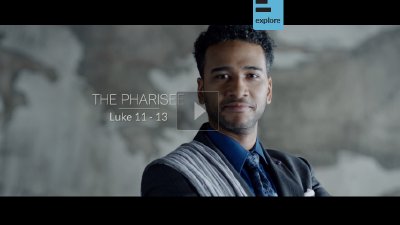


EYEWITNESS BIBLE SERIES
Curated Broadcast of Narrated Bible Studies
JAMES THE APOSTLE
JAMES SON OF ZEBEDEE
JAMES THE APOSTLE Luke builds his Gospel by showing how Jesus calls his twelve apostles and then trains them. This training takes the form of spending time with Jesus, watching him do miracles and healings, and listening to his teachings. By Luke 9, the basic training is over and advanced training has started. Jesus empowers the apostles and gives them authority to drive out demons and cure people, and to teach about the Kingdom of God.
MARY MAGDALENE IN LUKE
Mary Magdalene
MARY MAGDALENE Over the centuries, many people have observed that Jesus was one of the first world leaders concerned with women’s rights. When it came to women, Jesus wasn’t as concerned with the day-to-day societal norms as he was with their worth. In many ancient societies, including the time when Jesus was born, women were considered property, with worth far below that of men—the Roman Empire even codified this in their laws. It was only during the following decades that women started receiving more legal rights.
THE MOST THANKFUL ANGEL
AN ANGEL
THE MOST THANKFUL ANGEL This episode has a subtle twist. It assumes seven appearances of unnamed angels dealing directly with Jesus shown in the Gospels are all by the same angel (not including Gabriel’s appearances). Using that twist, the backstory of the angel and its thankfulness are part of the story line. The seven appearances are: To tell Joseph about Mary (Mat. 1:20-24). Announce the birth of Jesus (Luke 2:9-15). To tell Joseph to take Jesus to Egypt to avoid Herod’s wrath (Mat. 2:13-14). To tell Joseph to move from Egypt back to Israel (Matthew 2:19-23). To attend to Jesus after the wilderness temptations (Matthew 4:11). To strengthen Jesus at Gethsemane (Luke 22:43). To roll away the stone of Jesus’ tomb and inform the women (Matthew 28:2-5).
LUKE 11-13 THE PHARISEE
The Pharisees were a Jewish sect that started two hundred years before Jesus. At times their identity shifted between a political party, a social movement, or a school of thought. They believed in the authority of virtually all of the Hebrew Bible (what we call the Old Testament) and had built an oral tradition of a vast number of interpretations. After the destruction of the Temple in 70 AD, their beliefs became foundational in Rabbinic Judaism.
BEYOND ACTS THEOPHILUS
THEOPHILUS
Characters: Theophilus Primary Scriptures: Acts 28 Story Summary: Some thoughts about what happens after Acts ends Location: Roman Empire Time: AD 30 Jesus crucified and resurrected; Pentecost; Holy Spirit arrives AD 46 First Missionary Journey starts AD 48 – 51 Second Missionary Journey AD 52-57 Third Missionary Journey AD 57-59 Paul arrested in Jerusalem; Paul imprisoned in Caesarea AD 59-62 Paul sent to Rome and imprisoned for two years AD 66 Start of First Jewish-Roman War AD 70 Destruction of the Temple
SECOND CORINTHIANS TITUS
Titus
Characters: Titus Primary Scriptures: Second Corinthians Story Summary: Paul’s second New Testament letter to the church in Corinth Location: Roman Empire; Greece, Corinth Time: AD 30 Jesus crucified and resurrected; Pentecost; Holy Spirit arrives AD 48 Paul’s “famine visit” to Jerusalem; First Missionary Journey starts AD 50 Council at Jerusalem; Start of Second Missionary Journey. AD 53 Start of Third Missionary Journey AD 56 Paul writes 1 Corinthians, 2 Corinthians
John Mark
Eyewitness Bible Series
Primary Scriptures: Acts 13 Story Summary: John Mark’s story, start of the First Missionary Journey Location: Roman Empire; Jerusalem, Antioch, Cyprus Time: 30 AD. Death, burial and resurrection of Jesus. Pentecost. 46 AD Paul’s “famine” visit to Jerusalem, start of First Missionary Journey The Scriptures give us only short, direct references about John Mark, but it is possible to infer many things about him that are likely to be representative of his life. Part of the inferences come from knowing that Jerusalem was a small city where the Christians knew each other and often interacted. Acts 12:12-13 says that after Peter was released from jail, he went to the house of Mary, the mother of John Mark, where many people had gathered and were praying. When Peter knocked at the door, a servant answered and recognized Peter’s voice. From just this short passage, we can infer from the very big house and servants that John Mark’s mother was wealthy and that, since her house was well-known to the Christians as a central gathering place, their family had likely been Christians for a long time. If the family was wealthy, John Mark was likely well-educated and knew many of the other wealthy people in Jerusalem, especially the Jewish leaders. The next passage illustrates the importance of searching all the Scriptures about a topic instead of just the ones currently in front of you. Colossians 4:10 says that Mark is a cousin (or relative) of Barnabas, and in that same verse, Paul tells the Colossians to welcome Mark if he comes to them. Paul wrote this passage many years after the First Missionary Journey, so you can infer from it that Mark somehow ended up in Paul’s good graces. We are not sure how that happened, but it is fun to speculate that John Mark’s training under Barnabas had a big influence. John Mark later became known as Mark, and he is typically credited with writing the New Testament book of Mark. He was not an original apostle.
PROMINENT WOMEN OF ACTS
This video is part of a series of created as an Exploration of Scripture to empower the viewer' Faith. A fascinating behind the scenes study of the people and stories that are the bedrock of the Christian faith. Ancient stories that still echo with deep significance for today's world through eyewitness accounts.









